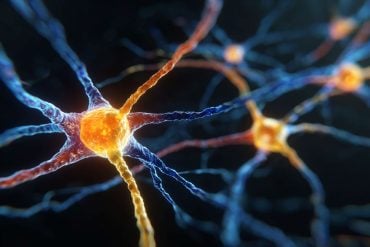Summary: Transcranial direct current stimulation (tDCS) may enhance cognitive function in Alzheimer’s disease patients.
The study involved 140 patients with mild to moderate Alzheimer’s, who received either active or sham tDCS twice daily for up to six weeks. Results indicated significant improvements in cognitive functions, such as word recall and recognition, in the active tDCS group after 30 sessions.
This improvement was associated with enhanced cortical plasticity, demonstrating tDCS’s potential as a promising intervention for Alzheimer’s cognitive impairment.
Key Facts:
- Cognitive Improvements with tDCS: Patients receiving active tDCS showed significant cognitive improvements compared to the sham group, particularly in memory and language functions.
- Enhanced Cortical Plasticity: The treatment appeared to improve the brain’s ability to form new neural connections, which correlated with cognitive gains.
- Potential for Alzheimer’s Treatment: These findings suggest that tDCS could be a significant intervention for improving cognitive function in Alzheimer’s disease patients.
Source: BMJ
Twice daily non-invasive electrical stimulation of the brain may boost mental processes (cognitive function) in people with Alzheimer’s disease, suggest the results of a small clinical trial published online in the open access journal General Psychiatry.
The technology, known as transcranial direct current stimulation, or tDCS for short, may help to fire up the brain’s plasticity, enabling ‘rewiring’ through the formation of new neural networks, the findings suggest.

tDCS comes in the form of a device with two electrodes, placed over specific areas of a person’s head, which deliver a constant low intensity electrical current. It is starting to be used in many areas of medicine, including for the treatment of depression.
The researchers wanted to find out if tDCS might improve cognitive function in people with Alzheimer’s disease, and if so, whether this might be linked to their recovering some level of cortical plasticity–the brain’s capacity to form new neural networks.
Some 140 patients with mild to moderate Alzheimer’s disease from four different hospitals were randomly allocated to receive either 2 daily sessions of active (constant low intensity 1-2 mA current) or sham tDCS, for 5 days of the week for a maximum period of 6 weeks.
The currents were applied to the prefrontal cortex, the region of the brain involved in higher order activities, such as planning, decision-making, working memory, moderating social behaviours, and controlling certain aspects of speech and language.
Participants were all aged over 65, had had their disease for more than 6 months, and had all scored below 26 on the Mini-Mental State Exam (MMSE). A score of 24 is regarded as abnormal and indicative of cognitive impairment. Both groups were comparable in terms of age, sex, and educational attainment.
The MMSE and the Alzheimer’s Disease Assessment Scale-Cognitive (ADAS-Cog) Test, which focuses on language and memory, were used to evaluate cognitive performance at the start of the trial, after 2 weeks, and again after 6 weeks.
Readings of electrical signalling through the motor pathways of the nervous system, known as motor evoked potential or MEP, were used to indicate changes in neural plasticity.
In all, 133 patients completed the 2-week intervention and 124 completed the 6-week intervention. Reasons for withdrawal varied, but no one withdrew because of discomfort.
The results showed that after 2 weeks there was no change in either group, but compared with baseline, 30 daily 20-minute sessions of tDCS significantly improved the cognitive function of those in the tCDS group, particularly their word recall, recall of test instructions, and word recognition. No such improvements were seen in the sham group.
The results also showed that in people with Alzheimer’s disease cortical plasticity is impaired, but that this improved after 6 weeks of tDCS.
In tandem with a decrease in MEP, word recall and word recognition got better among those in the tDCS group, but not among those in the sham group, suggesting that the improvement in cortical plasticity may reflect the degree of cognitive improvement, say the researchers.
But it’s still not clear how tDCS might exert its effects, they add, citing previous research, indicating that the technology may alter ion activity, neurotransmitter release, and electrical activity in various areas of the brain.
The researchers acknowledge various limitations to their findings, including the small study size, the lack of MRI or electroencephalography scans to chart changes in brain structure, and the absence of cerebrospinal fluid and blood samples to monitor neurotransmitter changes.
But they nevertheless conclude: “The results of this study strongly indicate that tDCS treatment is a significant and promising intervention for improving cognitive function in [Alzheimer’s disease]. In addition, plasticity plays a vital role in cognitive change.”
About this Alzheimer’s disease research news
Author: BMJ Media Relations
Source: BMJ
Contact: BMJ Media Relations – BMJ
Image: The image is credited to Neuroscience News
Original Research: Open access.
“Impact of twice-a-day transcranial direct current stimulation intervention on cognitive function and motor cortex plasticity in patients with Alzheimer’s disease” by Xingxing Li et al. General Psychiatry
Abstract
Impact of twice-a-day transcranial direct current stimulation intervention on cognitive function and motor cortex plasticity in patients with Alzheimer’s disease
Background
Non-invasive brain stimulation has improved cognitive functions in patients with Alzheimer’s disease (AD), and some studies suggest a close relationship between cognition and plasticity. However, the clinical benefits of transcranial direct current stimulation (tDCS) in patients still need to be evaluated.
Aims
This study examined the role of tDCS in improving cognition and whether the improved cognition is related to altered cortical plasticity.
Methods
124 patients with AD were randomly assigned to active tDCS (n=63) or sham tDCS (n=61). The tDCS was applied at the dorsolateral prefrontal cortex for 30 treatment sessions across 6 weeks (5 days per week, 2 days off). The Mini-Mental State Examination and the Alzheimer’s Disease Assessment Scale-Cognitive (ADAS-Cog) were used for cognition evaluation at baseline, week 2 and week 6. The cortical plasticity was represented by motor-evoked potential (MEP) measured with an electromyogram.
Results
The results showed that multiple courses of active tDCS can improve the cognitive functions of patients with AD, especially in the memory domain (word recall, recall of test instructions and word recognition). In addition, the damaged MEP level was enhanced following active treatment. In the active tDCS group, the improvements in ADAS-Cog total and subitem (word recall and word recognition) scores were negatively correlated with the enhancement of MEP.
Conclusions
Our research indicates for the first time that twice-a-day tDCS may improve the cognitive function of patients with AD. This study also suggests that cognitive dysfunction may be related to impaired cortical plasticity, which warrants mechanistic investigations of the relationship between cognition and plasticity in the future.
Trial registration number
ChiCTR1900021067.






